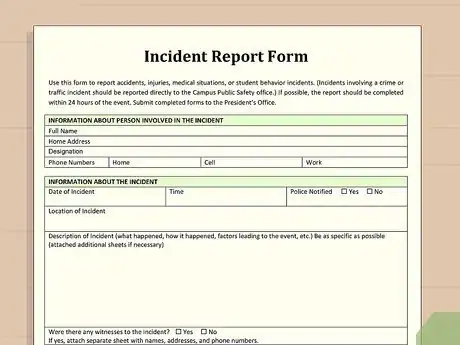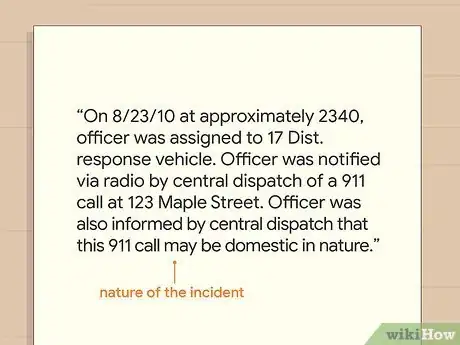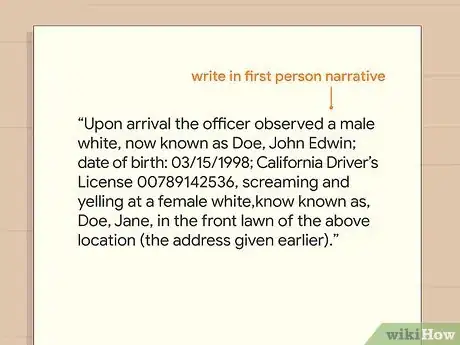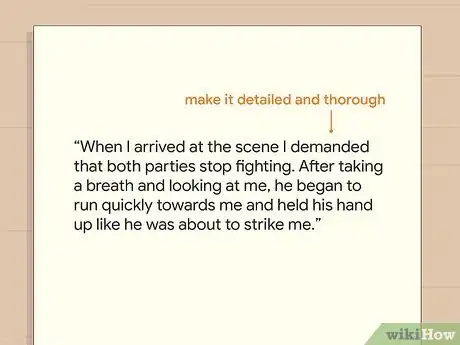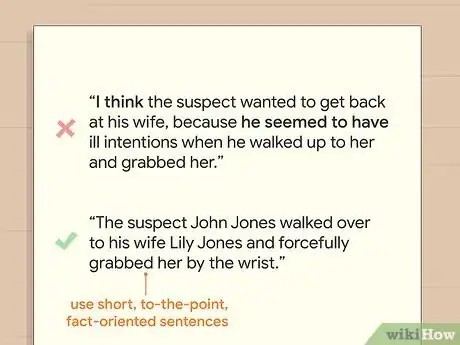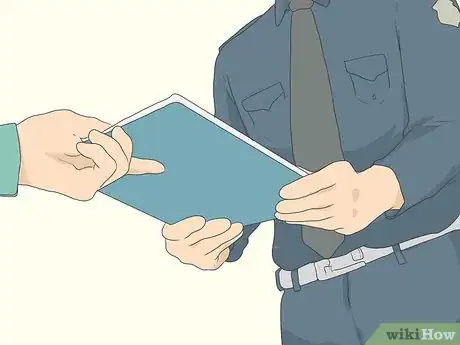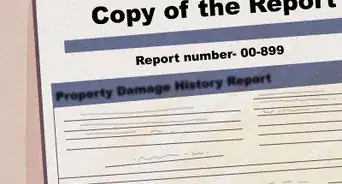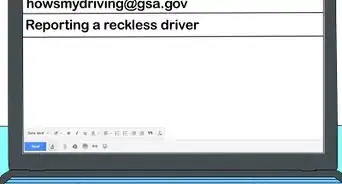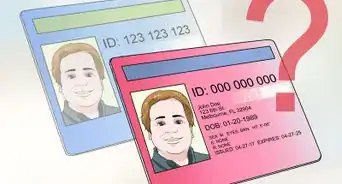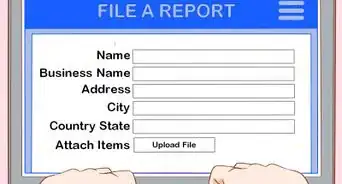This article was co-authored by Clinton M. Sandvick, JD, PhD. Clinton M. Sandvick worked as a civil litigator in California for over 7 years. He received his JD from the University of Wisconsin-Madison in 1998 and his PhD in American History from the University of Oregon in 2013.
wikiHow marks an article as reader-approved once it receives enough positive feedback. This article received 19 testimonials and 80% of readers who voted found it helpful, earning it our reader-approved status.
This article has been viewed 1,156,533 times.
If you're a security guard or police officer deployed to the scene of an incident, writing up a detailed and accurate report is an important part of doing your job correctly. A good incident report gives a thorough account of what happened without glossing over unsavory information or leaving out important facts. It's crucial to follow the appropriate protocol, describe the incident clearly, and submit a polished report.
Things You Should Know
- Get the correct forms from your institution. Pay attention to any special instructions since forms may vary slightly.
- Note the time, date, and location of the incident on the form. Include your full name and ID number, as well.
- Write a first person narrative explaining what happened at the scene. Be honest, clear, and concise.
- Proofread your incident report and revise any mistakes before submitting it.
Steps
Following Protocol
-
1Obtain the proper forms from your institution. Each institution has a different protocol in place for dealing with an incident and filing a report.
- Follow any instructions that accompany the forms. Each organization uses a different format, so pay attention to the guidelines.
- In some cases you're responsible for filling out a form issued by your institution. In other cases you'll be asked to type or write up the report on your own.
Tip: If possible, do your write up using word processing software. It will look neater, and you'll be able to use spell check to polish it when you're finished. If you write your report by hand, print clearly instead of using cursive. Don't leave people guessing whether your 7s are actually 1s.
-
2Provide the basic facts. Your form may have blanks for you to fill out with information about the incident. If not, start the report with a sentence clearly stating the following basic information:
- The time, date and location of the incident (be specific; write the exact street address, etc.).
- Your name and ID number.
- Names of other members of your organization who were present
Advertisement -
3Include a line about the general nature of the incident. Describe what brought to you at the scene of the incident. If you received a call, describe the call and note what time you received it. Write an objective, factual sentence describing what occurred.
- For example, you could write that you were called to a certain address after a person was reported for being drunk and disorderly.
- Note that you should not write what you think might have happened. Stick to the facts, and be objective.
-
4Start the report as soon as possible. Write it the same day as the incident if possible. If you wait a day or two your memory will start to get a little fuzzy. You should write down the basic facts you need to remember as soon as the incident occurs. Do your report write-up within the first 24 hours afterward.
Describing What Happened
-
1Write a first person narrative telling what happened. Write a chronological narrative of exactly what happened when you reported to the scene.
- Use the full names of each person included in the report. Identify all persons the first time they are cited in your report by listing: first, middle, and last names; date of birth, race, gender, and reference a government issued identification number. In subsequent sentences, you can then refer to them using just their first and last names: "Doe, John" or "John Doe". Start a new paragraph to describe each person's actions separately. Answer the who, what, when, where, and why of what happened.
- For example, when the police officer mentioned above arrives at the residence where he got the call, he could say: "Upon arrival the officer observed a male white, now known as Doe, John Edwin; date of birth: 03/15/1998; California Driver's License 00789142536, screaming and yelling at a female white,know known as, Doe, Jane, in the front lawn of the above location (the address given earlier). The officer separated both parties involved and conducted field interviews. The officer was told by Mr. John Doe that he had came home from work and discovered that dinner was not made for him. He then stated that he became upset at his wife Mrs. Jane Doe for not having the dinner ready for him."
- If possible, make sure to include direct quotes from witnesses and other people involved in the incident. For example, in the above scenario, the officer could write “Jane said to me ‘Johnny was mad because I didn’t have dinner ready right on time.'”
- Include an accurate description of your own role in the course of what occurred. If you had to use physical force to detain someone, don't gloss over it. Report how you handled the situation and its aftermath.
-
2Be thorough. Write as much as you can remember - the more details, the better. Don't leave room for people reading the report to interpret something the wrong way. Don't worry about your report being too long or wordy. The important thing is to report a complete picture of what occurred.
- For example, instead of saying “when I arrived, his face was red,” you could say, “when I arrived, he was yelling, out of breath, and his face was red with anger.” The second example is better than the first because there are multiple reasons for someone’s face to be red, not just that they are angry.
- Or, instead of saying “after I arrived at the scene, he charged towards me,” you should say “when I arrived at the scene I demanded that both parties stop fighting. After taking a breath and looking at me, he began to run quickly towards me and held his hand up like he was about to strike me.”
-
3Be accurate. Do not write something in the report that you aren't sure actually happened. Report hearsay as hearsay, not as fact.
- For example, if a witness told you he saw someone leap over a fence and run away, clearly indicate that your report of the incident was based upon a witness account; it is not yet a proven fact.
- Additionally, if you are reporting what the witness told you, you should write down anything that you remember about the witness's demeanor. If their statement's cause controversy later, your report can prove useful. For example, it would be helpful to know that a witness appeared excited while telling you what happened, or if they seemed very calm and evenhanded.
-
4Be clear. Don't use flowery, confusing language to describe what occurred. Your writing should be clear and concise. Use short, to-the-point, fact-oriented sentences that don't leave room for interpretation.
- Keep your writing clear and concise.
- Additionally, do not use legal or technical words: For example, say “personal vehicle” instead of “P.O.V.” (personally owned vehicle), and “scene of the crime” instead of the typical numbered code that police typically use to notify others of their arrival.
- Use short, to-the-point sentences that emphasize facts and that don't leave room for interpretation. Instead of writing "I think the suspect wanted to get back at his wife, because he seemed to have ill intentions when he walked up to her and grabbed her," write "The suspect [insert name] walked over to his wife [name] and forcefully grabbed her by the wrist."
-
5Be honest. Even if you're not proud of how you handled the situation, it's imperative that you write an honest account. If you write something untrue it may end up surfacing later, putting your job in jeopardy and causing problems for the people involved in the incident. Preserve your integrity and that of the institution you represent by telling the truth.
Polishing the Report
-
1Double check the basic facts. Check to make sure the basic information (spellings of names, the dates, times, and addresses, the license plate numbers, etc.) match those you listed in your report.
- Do not try to make sure that statements in your report match those of your colleagues. Individually filed reports guarantee that more than one account of an incident survives. Incident reports can appear later in a court of law. If you alter the facts of your report to match those of another, you can be penalized.[1]
-
2Edit and proofread your report. Read through it to make sure it's coherent and easy to understand. Make sure you didn't leave out any information that should have been included. Look for obvious gaps in the narrative that you might need to fill in.[2]
- Check it one more time for spelling and grammar errors.
- Remove any words that could be seen as subjective or judgmental, like words describing feelings and emotions.
-
3Submit your incident report. Find out the name of the person or department to whom your report must be sent. When possible, submit an incident report in person and make yourself available to answer further questions or provide clarification. In situations where an incident report must be mailed or e-mailed, follow up with a phone call within a 10 day period to ensure that your report was received.
References
About This Article
If you need to write an incident report, start writing down the basic facts you need to remember as soon as possible, so you don’t start to forget details. Include the time, date, and location of the incident, as well as your name and work ID number and the names of anyone else who was present. Start by describing the general nature of the incident, then write out a detailed, first-person account of what happened. Include as many details as you can. Keep reading for tips on editing and polishing your report.
